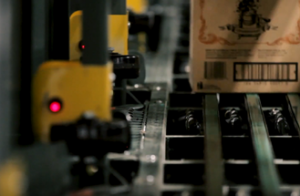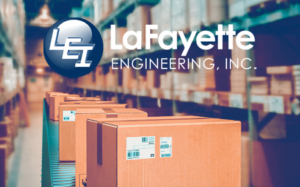Table of Contents
Sortation conveyors are highly versatile and tailored to meet the needs of modern businesses that handle high volumes of goods. In today’s fast-paced world of e-commerce and warehousing, efficient and accurate product handling is essential for staying competitive. At the core of these operations is the sortation conveyor system, a crucial technology for managing and directing products to their correct destinations.
At Lafayette Engineering, we understand the critical role sortation conveyors play in ensuring smooth, efficient, and timely operations. In this blog, we will delve into the details of sortation conveyors, explore different types of sortation systems, weigh their pros and cons, and provide insights into how they can significantly boost your facility’s performance.
What Are Sortation Conveyors?
Sortation conveyors are automated systems designed to direct items, packages, or products to specific locations within a warehouse, distribution center, or fulfillment center. These systems identify products (usually through barcodes, RFID, or sensors) and direct them to their appropriate destinations using a series of diverters, belts, and other mechanisms.
The role of a sortation system becomes particularly important in large-scale operations where thousands of items are handled each day. From small to large packages, fragile to durable goods, sortation conveyors can manage a wide range of products while maintaining accuracy and efficiency. These systems reduce manual labor, increase throughput, and minimize errors, making them indispensable in industries such as e-commerce, manufacturing, and logistics.
Key Types of Sortation Conveyors
There are several types of sortation conveyors, each designed to cater to specific operational needs. Selecting the right system depends on factors such as product type, volume, speed requirements, and available space. Below are some of the most popular types:

1. Sliding Shoe Sorters
Sliding shoe sorters are a popular choice in high-volume environments. They use diverting mechanisms (referred to as “shoes”) that slide across the conveyor belt, gently pushing products off the conveyor and onto a designated destination lane.
Advantages:
- High speed: Sliding shoe sorters can sort items at a rate of 150 to 450 feet per minute, making them ideal for large-scale operations.
- Versatility: They can handle a variety of product shapes and sizes, including delicate items.
- Accuracy: High sorting accuracy reduces errors in the order fulfillment process.
Disadvantages:
- Initial investment: These systems can be expensive to install, making them more suitable for larger facilities with high throughput demands.
- Maintenance: Due to their complex mechanisms, sliding shoe sorters require regular maintenance to ensure smooth operation.
2. Tilt Tray Sorters
Tilt tray sorters use trays mounted on a continuous loop conveyor. As each tray reaches the correct destination, it tilts to release the product into a chute or bin.
Advantages:
- Flexible product handling: Tilt tray sorters can handle a wide range of product types, from small to large and from lightweight to heavier items.
- Scalability: These systems are modular, meaning they can be expanded to accommodate increasing volumes as your business grows.
- Reduced damage: Products are gently deposited, which minimizes damage during sorting.
Disadvantages:
- Space requirements: Tilt tray sorters take up more space than other systems, making them unsuitable for facilities with limited room.
- Speed: While effective, tilt tray sorters may not match the high speed of other sortation systems, such as sliding shoe sorters.
3. Cross-Belt Sorters
Cross-belt sorters are similar to tilt tray sorters, but instead of tilting trays, they use individual belts that run perpendicular to the main conveyor flow. When a product reaches its designated point, the belt accelerates, pushing the product into the correct chute.
Advantages:
- Accuracy: Cross-belt sorters are known for their precision, making them ideal for high-accuracy operations such as e-commerce order fulfillment.
- Versatile handling: These systems can handle irregularly shaped items that other systems might struggle with.
- Speed: Cross-belt sorters offer relatively high throughput and work well in facilities handling diverse product sizes.
Disadvantages:
- Cost: Like sliding shoe sorters, cross-belt sorters come with a higher price tag and maintenance cost due to their sophisticated technology.
- Energy consumption: These systems can consume more energy compared to other types of sorters, particularly in larger installations.
4. Pop-Up Wheel Sorters
Pop-up wheel sorters consist of rows of wheels that “pop up” to redirect products off the main conveyor to different destinations. These systems are often used in smaller operations where space is limited and product handling is straightforward.
Advantages:
- Compact design: Their relatively small footprint makes them ideal for facilities with space constraints.
- Cost-effective: Pop-up wheel sorters are typically more affordable than other sorting systems.
- Low maintenance: These systems are simpler in design and require less maintenance.
Disadvantages:
- Limited capacity: They are not ideal for high-volume operations, as they are designed for lower throughput rates.
- Product limitations: Pop-up wheel sorters work best with products that have flat, uniform surfaces. Irregularly shaped or delicate items may not be suitable for this type of system.
Benefits of Implementing Sortation Conveyors
1. Increased Efficiency
Sortation conveyors significantly reduce the time it takes to move products through a warehouse or distribution center. They streamline the sorting process, allowing items to be directed to the appropriate location with minimal human intervention.
2. Improved Accuracy
The automation provided by sortation conveyors reduces human error. The system can accurately identify and route products based on real-time data, ensuring that the right items end up in the right place.
3. Cost Savings
Although the initial investment in a sortation conveyor system can be substantial, the long-term savings are significant. By reducing manual labor, minimizing errors, and increasing throughput, these systems can lower operating costs and boost profitability.
4. Scalability
As your business grows, so can your sortation system. Most conveyor systems, particularly tilt tray and cross-belt sorters, can be expanded to accommodate higher volumes, making them ideal for businesses with growth potential.
5. Enhanced Customer Satisfaction
Faster and more accurate sorting translates to faster order fulfillment. By meeting delivery deadlines and minimizing errors, businesses can enhance customer satisfaction, leading to repeat business and positive reviews.
Considerations When Choosing a Sortation Conveyor System
When selecting a sortation conveyor system for your facility, several factors need to be considered:
- Throughput requirements: How many items per hour do you need to sort? High-throughput systems like sliding shoe sorters or cross-belt sorters might be necessary for larger operations.
- Product variety: Consider the types of products you handle. Irregularly shaped or delicate items may require specific systems like cross-belt or tilt tray sorters.
- Available space: Some systems, such as pop-up wheel sorters, are more compact and better suited for facilities with limited space.
- Budget: Sortation systems can be a significant investment. It’s essential to balance the system’s upfront cost with its long-term benefits and savings.
- Future growth: Choose a system that can scale with your business. Modular systems like tilt tray sorters allow for future expansion without major overhauls.
Conclusion
Sortation conveyors are a critical component of modern warehouses and distribution centers, offering a wide range of benefits from improved efficiency to reduced costs. Whether your facility handles high volumes of small packages or a diverse range of products, there’s a sortation conveyor system designed to meet your needs.
At Lafayette Engineering, we specialize in helping businesses optimize their operations with custom sortation conveyor solutions. Whether you’re looking to implement a new system or upgrade your existing one, our experts are here to assist you every step of the way.
For more information on how we can help you, visit Lafayette-Engineering.com today.



